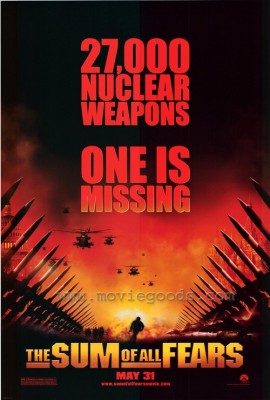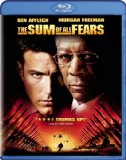| Reviews & Columns |
|
Reviews DVD TV on DVD Blu-ray 4K UHD International DVDs In Theaters Reviews by Studio Video Games Features Collector Series DVDs Easter Egg Database Interviews DVD Talk Radio Feature Articles Columns Anime Talk DVD Savant Horror DVDs The M.O.D. Squad Art House HD Talk Silent DVD
|
DVD Talk Forum |
|
|
| Resources |
|
DVD Price Search Customer Service #'s RCE Info Links |
|
Columns
|
|
|
Sum of All Fears, The
The film's timing was either dreadful or opportune, depending on how you looked at it. Filmed just prior to the terrible tragedies of 9/11, it was released the following May, kicking off that summer's blockbuster season. The movie never exploits 9/11 directly, but in some respects anticipates darker trends in American cinema, without quite crossing the line into crass exploitation itself. On its own terms and viewed with six years of hindsight, it's a fairly good thriller overall, just flawed in a couple of major ways.
Paramount's Blu-ray is another over-manipulated mess, about as bad as Clear and Present Danger though not as extreme as Patriot Games. Scattered shots look terrible and jarringly draw attention to themselves, though most of the time it's not ruinously distracting.
What, me worry? High-concept advertising, just six months after 9/11
The story concerns efforts by an Austrian neo-Nazi, Richard Dressler (Alan Bates, very good in one of his last performances), to revive Fascism on a global scale. In a smoothly-written monologue, he makes the case that the Internet and other technologies have made the world much smaller while at the same time racial and religious tensions have only grown more strained, an ideal climate in which to platform his hate-mongering. Hitler's mistake, he says, was taking on the United States and Russia. Just like Ernst Blofeld in the film of You Only Live Twice, Dressler's plan is to pit one against the other. You'd think there wouldn't be much world left to conquer after a nuclear war between the two superpowers but, well, these neo-Nazi nuts are crackpots after all. Dressler's plan entails retooling a recovered nuclear bomb lost during the Yom Kippur War of 1973, when an Israeli A-4 jet was shot down over Syria and its payload was buried deep in the desert sands.
Meanwhile, in post-Soviet Union Russia, Alexander Nemerov (Irish actor Ciaran Hinds, giving the film's best performance) becomes its new president, which worries U.S. President Fowler (James Cromwell) and his cabinet. They suspect Nemerov is a hardliner along the lines of real-world president Vladimir Putin. Young CIA analyst Jack Ryan (Affleck) is called by CIA Director William Cabot (Morgan Freeman, assuming the James Earl Jones role in all but name) into a special security meeting owing to Ryan's extensive research on Nemerov. However, nobody buys Ryan's theories that Nemerov is more progressive that he's letting on. Nemerov seems to prove Ryan wrong when the Chechen capital of Grozny is decimated with chemical weapons, though rogue military-types were actually responsible.
Tensions escalate between the two countries while Dressler's agents quietly move their nuclear device toward America's East Coast.
The Sum of All Fears is suspenseful and very slickly made, and for the most part avoids many of the pitfalls of recent thrillers. I find Ben Affleck a singularly uninteresting, sometimes embarrassing actor, a kind of Generation X John Agar, but here he's serviceable and the script, credited to Paul Attanasio (Homicide: Life on the Street) and the much less interesting Daniel Pyne (Miami Vice, Doc Hollywood), gives him good material to work with.
After looking at the four Jack Ryan films back-to-back, it's clear that the root of the character's appeal, at least in the film adaptations, is in watching Ryan the researcher at work, analyzing data and drawing logical conclusions, then going out on a limb trying to convince his superiors - who are constantly factoring in the political ramifications of their decisions - that his unlikely conclusions are correct. Audiences identify with Ryan because while he's an employee of the CIA his job has the deglamorized appearance of myriad other white collar jobs, and we share his combination of excitement and trepidation testifying and giving advice to the highest policy-makers in government.
The Sum of All Fears succeeds at this much more successfully than the two Harrison Ford pictures though not as well as The Hunt for Red October, mainly because here there's not enough footage of Ryan convincing us that he's done his homework the way Alec Baldwin's Ryan did. Affleck's character relies too much on hunches and gut feelings. Also rather clunky are scenes involving Jack's girlfriend (Bridget Moynahan), a character who seems to exist solely to give him someone to bounce his emotions off of, and for overly-cute scenes about Ryan's rocky love life, and how imminent nuclear disaster can put a cramp on one's dating.
In the novel the villains were Muslim extremists, and many assumed this was changed to neo-Nazis because of 9/11. In fact in distilling Clancy's long novel into a workable screenplay the filmmakers didn't believe a small band of Islamic extremist could on their own pull off such a spectacular attack on American soil. Little did they know.
But while The Sum of All Fears avoids Muslim stereotyping it still reflects a fatalistic attitude toward nuclear weapons and terrorism, and comes off as xenophobic and isolationist. The film gets off to a curious start, a nuclear emergency that - surprise! - turns out only to be a "fire drill" which the President and his staff laugh off (Har! Har!). Though the world isn't destroyed in the end, it's only through Jack Ryan's incredible persistence that it survives at all: everyone else seems intent on pressing The Button.
While ours is a country of Super Bowl football and picnics in the park (more on this below) the rest of the world is depicted as enormously unattractive and about a hundred years behind the times. Russia resembles Russia of 1917 more than 2002, while the Syrian bomb-peddlers are seen in nomadic tents straight out of Lawrence of Arabia.
(Major Spoilers Ahead): The film has exceptionally strange notions about nuclear blasts and fallout, and the psychological impact such events would have on those who survive them. When Dressler's (comparatively) small nuclear bomb is detonated in Baltimore, characters near the blast unaccountably are immune to radiation poisoning, including Ryan, his girlfriend, and the U.S. President. Later, Jack goes snooping around Ground Zero, again unconcerned about the potential health risks.
But what really surprised many critics and audiences was the film's outrageous, all-smiles happy ending, which finds Ryan and his new fiancée happily picnicking near the White House - apparently just days after the Big Blast less than 40 miles away. (And where, presumably, they're still sifting through the giant heap of charred corpses. Pass the chicken salad, hon.) Neither seems concerned about the physical effects of surviving a nuclear explosion, is in need psychological counseling, compelled to attend funerals, watch the news, nothing. While in its defense the film was shot prior to 9/11, nevertheless before the movie opened this scene absolutely should have been scrapped and replaced with something more sobering and believable. Though director Paul Alden Robinson tastefully avoids showing people being vaporized while, later on, hinting at the aftereffects by showing a a few burned bodies at a nearby hospital, the unimaginable horror of such an event isn't properly conveyed. Not since Panic in Year Zero (1962) has an American movie been so naively optimistic about a nuclear attack.
Video & Audio
As with Patriot Games and Clear and Present Danger (though not The Hunt for Red October), Paramount totally messed up the 1080p video transfer, needlessly over-processing the film like mad. Some shots are so drop-dead awful they really sucked me right out of the movie ("Boy, does that look like crap!"). In one wide angle shot early in the film (in Panavision with lab work by Deluxe), some characters are standing outside an enormous nuclear bunker, a real one as it turns out, built in Canada. Because of the over-processing, including artificial sharpening and egregious DNR, instead of the shot appearing more life-like it actually looks singularly fake: the real-life background has been rendered into something resembling painted canvas, the kind of thing you'd see at an old Vaudeville house. I've asked this before but I'll ask it again: Didn't somebody QC this on a big screen TV before it was approved? Did anyone really think this looked good? If anyone at Paramount Home Entertainment would like to respond to these criticisms, I'd be happy to post their reply in this review.
Originally a DTS/Dolby Digital Stereo release, the Blu-ray offers a pretty good remixed 5.1 Dolby Digital TrueHD track along with 5.1 Dolby Digital stereo tracks in French and Spanish, along with subtitles in all three languages plus Portuguese.
Extra Features
A trailer for the film is likewise presented here in 1080p high-definition, and like the trailers for the Harrison Ford titles it underscores what the film might have looked like without all the unwanted manipulation.
Also included are three featurettes, all promo type material shot for the most part prior to the film's theatrical release. Most of the stars appear; Freeman must be a publicist's dream - he enthusiastically has nice things to say about absolutely everyone. Soft-spoken, intelligent director Phil Alden Robinson (Field of Dreams), not the obvious choice for this type of material, has some interesting things to say in two commentary tracks, one which matches him up with author Tom Clancy. It's not quite the contrast spleen-venting director Sidney J. Furie and charming, upbeat editor Peter Hunt were on The Ipcress File, but they make a similarly interesting pair. (The other track puts Robinson with cinematographer John Lindley).
Parting Thoughts
American audiences probably weren't really ready for a thriller like The Sum of All Fears so soon after 9/11 (I wasn't; I avoided it for that very reason), but several years later it's possible to see the film more clearly for what it is, a pretty good thriller that, despite its bizarrely upbeat ending, is the second-best Jack Ryan movie to date, and while the Blu-ray transfer is a disappointing and distracting, it doesn't ruin the viewing experience, either. Modestly Recommended.
Film historian Stuart Galbraith IV's latest book, The Toho Studios Story, is on sale now.
|
| Popular Reviews |
| Sponsored Links |
|
|
| Sponsored Links |
|
|
| Release List | Reviews | Shop | Newsletter | Forum | DVD Giveaways | Blu-Ray | Advertise |
|
Copyright 2024 DVDTalk.com All Rights Reserved. Legal Info, Privacy Policy, Terms of Use,
Manage Preferences,
Your Privacy Choices | |||||||














